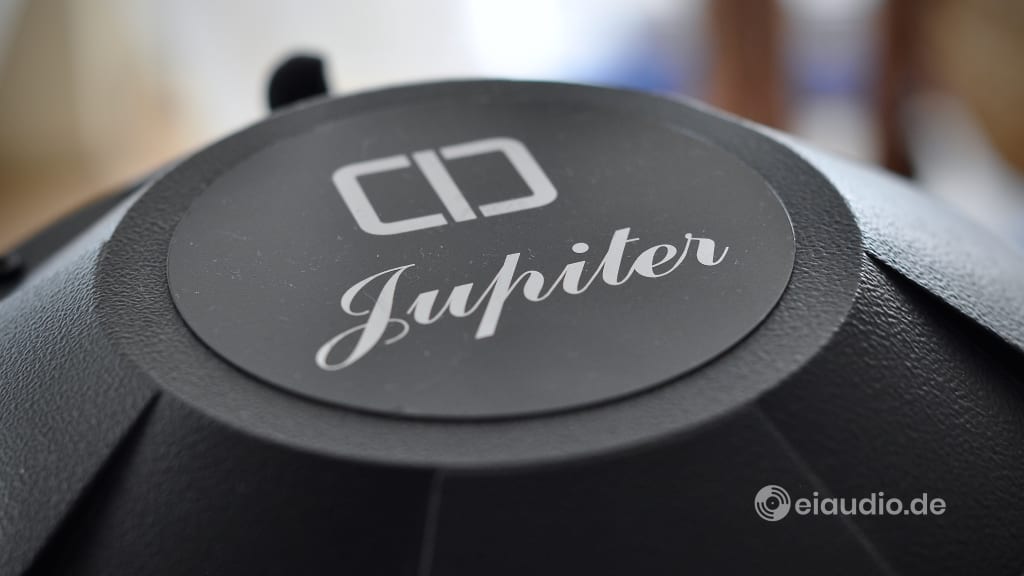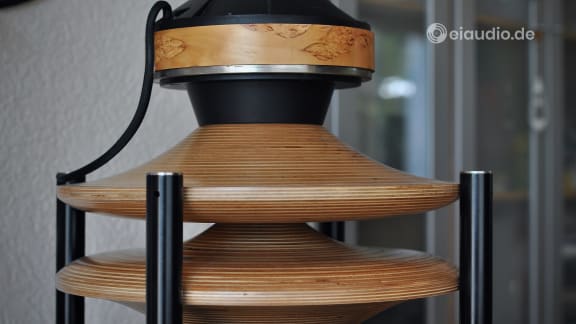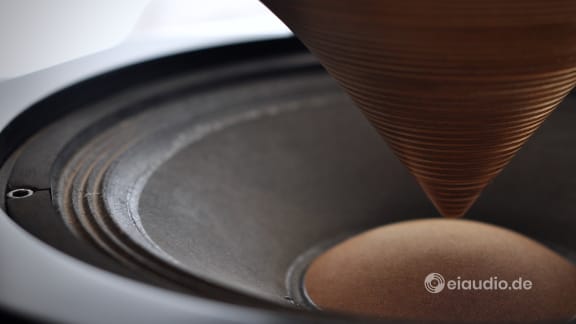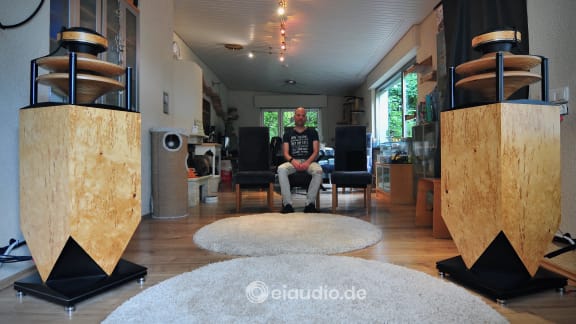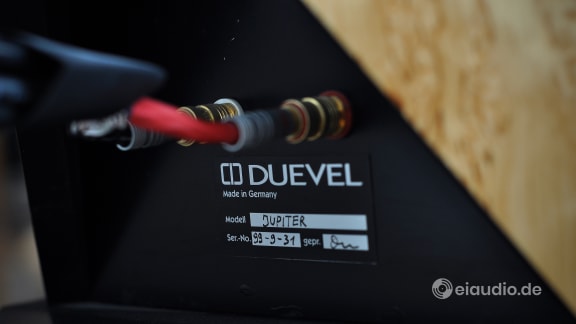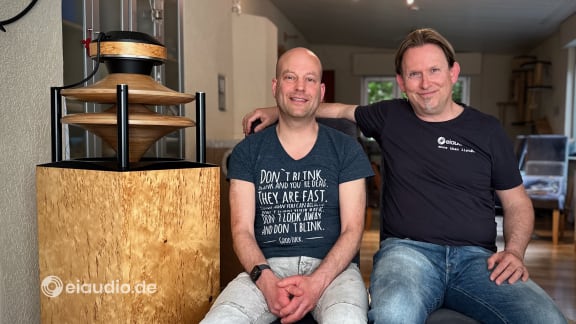Duevel Jupiter, Series-1
Published: 12/05/2024
Manufacturing date: 1998
Author: Karsten Hein
Category: Gear & Review
Tag(s): Loudspeakers
A Personal Journey
Matthias was not the one to take decisions lightly. His background in electronic engineering, paired with extensive reading and long-time experience in setting up HiFi equipment, had granted him a sophisticated setup, and his exploration of new devices seemed complete for the time being. Instead, he had once again shifted his focus towards the music itself and was happily listening on his Devialet Expert 250 amplifier paired with Duevel Bella Luna loudspeakers. The Devialet was a modern and hybrid device with internal DAC, built-in room correction, versatile connectivity, and a cleverly designed 250 Watts per channel output stage that was fed from a digital power supply, capable of producing bursts of up to 4000 Watts, all at generally very low noise levels. This amplifier made the Bella Lunas present all kinds of music with great ease. And such was also my very positive verdict following my visit to Matthias’ house back in May 2023.
In Spring 2024, less than a year after my visit, Matthias informed me that he was contemplating upgrading from his accustomed Bella Luna loudspeakers to Duevel’s flagship of that period, the Jupiter. He explained that these speakers had once been completely unaffordable and that they had dropped in price over a 25-year period, thereby becoming quite attractive. And although used specimens of these speakers were rarely found, a pair of Jupiters was being offered within comfortable reach. Matthias was facing a dilemma because, on the one hand, he really was satisfied with his Bella Lunas, while the larger and more elaborate Jupiter, on the other hand, held the promise of being even more capable in every conceivable way. As I was listening to Matthias contemplating if he were to take this leap of faith, I could feel the tingling sensation that captivates me before each new exploration and has led to the birth of this blog. And so I simply told him that, if he took the plunge, I would come and write about it.
Jupiter vs. Bella Luna
Matthias auditioned the Jupiter at their seller’s house twice before making his decision. On the second occasion, he even brought his Devialet amplifier and his preferred loudspeaker cables along to see if this would bring the Jupiters to life. Happy with the result, he wrapped them in blankets and drove them back to his house with anticipation. Positioned side by side, the Jupiters dwarfed the already quite impressive Bella Lunas to an unanticipated extent. Being 22 cm taller and 10 cm wider appeared less significant on paper than in real life. The one aspect that might have given this considerable difference away was the increase in weight: from the still moderate 30kg on each Bella Luna to the impressive 70kg on each of the Jupiters. One benefit of the larger cabinet was a 10 Hertz drop in the lower cut-off frequency, down to 30 Hz. While Matthias was getting used to the Jupiters’ dimensions in his living room, he critically listened to them, until his doubts subsided and he finally put his Bella Lunas on sale.
Duevel loudspeakers are niche products and therefore not necessarily easy to sell. However, we decided to put the terms “omnidirectional” and “high end” in the advertisement header and soon managed to find a new home for them. There are fan communities for omnidirectional speakers, because some audiophiles believe that dipoles and omnidirectional speakers are the only means by which the authentic sound stage can be recreated in the listening room. Both the Bella Lunas and the Jupiters are omnidirectional 2-way speakers that have their drivers placed in horizontal position and employ wooden horn diffusers to disperse the sound in a 365-degree radius. While both speakers use an up-firing dynamic bass driver with die-cast chassis and M-roll surrounds, the Jupiters employ a high-output PA driver with paper cone that is 10 cm larger in diameter than that of the Bella Lunas.
The Listening Session
To match the performance of the larger bass driver, the tweeter section of the Jupiter needs to be much larger (10cm instead of 4.4cm) and must reach much lower as well. As a consequence, the Jupiter’s treble drops off 3,000 Hz earlier, at 20,000 Hz. And although this is already well outside most people’s hearing, the Jupiter’s treble shows greater sensitivity to subtle changes in the front end, the interconnects, and the choice of speaker cables. Both cabinets are designed to operate on the principle of a Helmholtz resonator, using one bass-reflex port calculated to the lowest cut-off frequency in each of the four cabinet corners. Strong internal bracing assures that the bass is dry and without much internal reverberation, even when the speakers are driven at high volume. The high and low frequency drivers of the Jupiter taken together contribute almost 20kg in weight to each speaker.
Matthias and I arranged a listening session for mid-May, right about the time I had first listened to the Bella Lunas one year earlier. We also invited Michael and Alexi, who had been with us on the first occasion; however, only Michael managed to free himself up for the event. Instead of two studio mics for the creation of a YouTube clip, this time, I brought along a calibrated UMIK-1 microphone and R.E.W. room analysis software on my MacBook to assist Matthias with the setup and positioning of the speakers. When I arrived in the early evening, I found the Jupiters standing at equal distance near the left and right walls of a relatively narrow but very deep living room. In this position, there was about 1/5 of space behind the speakers and about 4/5 towards the front. Their approximate position had been determined based on my calculation sheets on room modes that had been given to me by Peter English.
Quite a few things had changed since my last visit to the house: Matthias had covered the large terrace windows behind the Jupiters with drapes. The hardwood floor from the speakers towards the listening position was now covered with two rugs. The Devialet amplifier had been moved to a central position between the loudspeakers, and Matthias’ MacBook M1 (running Audirvana and Qobuz) was the only source for music. Two sets of speaker cables were running along the walls right up to the amplifier: The first cable was a DIY design braiding three solid-core CAT7 network cables AWG23 with two CAT7 multi-strands AWG26. And the second was a ready-made “White Bird - Reference” cable by Colours of Sound that was on loan from the manufacturer himself. To enhance the scope of our test, we also had an MIT “Terminator” (previously used on the Bella Lunas) and a Sommer Cable “Elephant” at our disposal.
Three chairs were positioned side by side, with the preferred listening position being the chair at the centre, and we took turns listening from all three positions and also tried kneeling in front or standing behind the central chair to get a better feel for the acoustics of the room. My personal preference would have been for the central chair to be moved a few centimetres forward, which produced greater speed and more detail, whereas Matthias preferred to keep the chairs in their current position for greater musical coherence. We started our listening session with the CAT7 network cables in place, playing Halie Loren’s title “Whiter Shade of Pale”, which was performed Live at the Cotton Club, and it quickly became clear that the Jupiters really could and were eager to move some air.
Performance and Impressions
After all, these speakers were built to handle up to 200 Watts of power coming from the amplifier, and their drivers, although quite sensitive even at one watt, were of sturdy build quality by nature. To be able to present their most linear performance, especially the dynamic bass driver required some momentum. The closer we got to realistic-to-live listening volumes, the more the speakers started to carry the sensation of live music. Their ability to faithfully play back frequencies all the way down to 30 Hz certainly enhanced this acoustic effect. The Jupiters’ omnidirectional horns created a deep soundstage that extended well beyond the speakers, right up to the front wall of the room. In our setup, the Jupiters had to be positioned quite close to the side walls which led to a mild blurriness of the phantom center. The amount of musical detail presented was sufficient but not staggering. It was just enough for the music to sound natural.
From the Planets to the Bella Luna, I have found a full and natural tonal balance to be the typical character trait of Duevel loudspeakers, and the Jupiters were no different in this respect. Due to this, it was possible to listen at higher volumes without fatigue. Further tracks included “Another Night” by Cody High and “Smoke on the water” Live in Osaka, 1972, by Deep Purple. I found that the Jupiters presented the quality of each recording well and also pointed out the limits. However, they equally served to highlight some unresolved issues in the setup and room. For one thing, the vertical motion of the woofer set the floorboards underneath the speakers in motion despite their colossal weight. This led to an unpleasant resonance in some songs. Matthias had used stone bases as a counter measure underneath the Bella Lunas. However, these proved to be too small in diameter for the Jupiters.
Matching Speakers and Cables
We also discovered that the Jupiters had not yet been set up to perform in a highly linear fashion. Measurements conducted with the UMIK-1 microphone in proximity to the listening position soon confirmed a 6dB drop in sound pressure levels between 80 and 180 Hz. While this effect might have served to enhance acoustic clarity, it also made these large speakers sound slower and less dynamic than would otherwise have been the case. I have sometimes found that larger drivers serve to accentuate room modes and resonances and demand more attention from their owners in terms of proper placement. Matthias was still getting to know his speakers, of course, and was learning how to best handle them from each new listening session.
Changing from the braided DIY CAT7 network cables over to the White Bird - Reference produced a more homogenous listening experience with a fuller bass at the cost of musical detail. Although our UMIK-1 frequency sweep measurements still showed the dip between 80 and 180 Hz, music is a complex occurrence that is difficult analyse when recording the response to a single frequency at a time. I enjoyed the increase in coherence, but I could see that Matthias remained reluctant to sacrifice the more revealing treble. Micheal agreed that the difference between these cables was so enormous that each of them presented a compromise, and so we decided to open up our test to include further cables.
Sommer Cable's “Elephant” proved to be a step back in many ways. It was less informative than both the CAT7 and the White Bird; it did not express tonal colours in a sufficiently vivid way, and transients were sorely lacking, although it did present low bass lines in a manner comparable to the White Bird. Given the sum of its character traits, Sommer’s Elephant cable could perhaps be a match for HiFi systems with an aggressive treble, however, it did feel out of place with the Jupiters. The MIT “Terminator” sounded more solid than any of the other cables. It presented the music in warm tonal colours and always with a bit of aristocratic restraint. There was a prevalent sense of order that would go well with a relaxing gala dinner or an evening in a cigar lounge. In comparison to the White Bird, it lacked some of the initial excitement, and, in comparison with the CAT7, the music seemed less forward and insightful with a reduction in stage depth and width.
Perspectives for Improvements
Further song titles we listened to in our session included “Nite Mist Blues” recorded Live at the Montreux Festival and performed by The Monty Alexander Trio; a further live recording “Empire State Express” by Richard Bargel; “Friday Smile” by Yello; “King of a Land” by Cat Stevens; and “Acoustic” by Billy Raffoul. Each song served to highlight different strengths and weaknesses of the current setup, and, in our minds, we compared the sound of the songs to the various HiFi systems we had heard before. For instance, I had listened to “Empire State Express” played on a Symphonic Line system with Görlich chassis just a few days earlier and vividly remembered the many layers of bass dynamics in this song. This effect did not show as much with the Jupiters while placed in their current position. I also remembered listening to “King of a Land” via our Martin Logan SL3 electrostatic speakers, with Cat Stevens coming alive almost “visually” right at the center of the stage, his voice felt so intimate one might think the artist was physically present in the room. Clearly, each loudspeaker has its own special field of expertise, but with the Jupiters I could sense that there was still a lot of potential waiting to be unleashed.
We all agreed that putting the speakers on stone slabs would enhance their imaging and help to reduce sub floor vibrations. These slabs would need to be of considerable size to accommodate the immense weight of the Duevels. Felt cushions underneath the stone slabs might be beneficial in further reducing the existing coupling to the ground. The speakers still needed to find their preferred position in the room, and Matthias and I agreed that it would be best to recalculate the exact distances, this time also taking into account some of the furniture in the room. Matthias also wanted to see if he could improve his DIY cable design by optimising the number of solid-core and multi-stand wires. We all liked the CAT7 cables and were eager to see how they would improve. By designing the cables himself, Matthias could learn more about the amplifier, his new speakers and the room.
The Devialet amp also offered built in SAM room compensation, however we had learned from past experience that the best sound was to be achieved if the speakers were positioned correctly in the first place. Like all great speakers, the Jupiters will force their owners to learn more about room acoustics and electronics in an effort to reach perfection. And it takes the heart of a true explorer to appreciate this challenge.
— Thank you for giving me the chance to write about it.
Specifications
- Type: floor-standing 2-way loudspeaker
- Design: omnidirectional, vented cabinet
- Frequency response (±3dB): 30 Hz - 20,000 Hz
- Power handling (RMS): 200 Watts (300 Watts, Series-2)
- High-frequency driver: 10cm titanium dome tweeter, horn-loaded
- Low-frequency driver: 32cm dynamic, paper diaphragm
- Woofer specifics: die-cast chassis, M-roll surround
- Diameter of horn diffusors: 385mm
- Gap between diffusors: 85mm
- Crossover frequency: 700 Hz
- Crossover design: phase-linear
- Power sensitivity (SPL): 92 dB (93 dB, Series-2)
- Nominal impedance: 6 Ohms
- Cabinet Dimensions: (H) 1270mm x (W) 380mm x (D) 380mm
- Base Dimensions: (W) 420mm x (D) 420mm
- Weight: 70 kg
- Country of manufacture: Germany
- Year(s): 1998 - 2008


